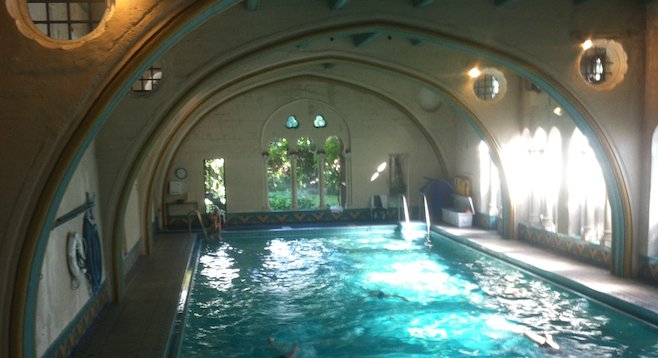 Facebook
Facebook
 X
X
 Instagram
Instagram
 TikTok
TikTok
 Youtube
Youtube

Smack dab in the middle of the hustle and bustle of Berkeley stands Julia Morgan’s “Little Castle.”
Old hotels hold a certain allure for me, and the Berkeley City Club is no exception. The stone structure projects an erect sense of grace and dignity that would be the envy of any of her socialite founders. Just shy of 90 years of age, this grand old dame transports its guest back to an era of class and privilege.
The architect was Julia Morgan, most famous for designing the Hearst Castle. Morgan was a remarkable woman and trailblazer. She broke through the glass ceiling before there was a name for it. Among her many accomplishments were being the first female graduate of the nearby University of California, as well as the first woman architect licensed in the state.
So when a group of prominent women decided they needed a social club constructed, whom else would they turn to? The architect said yes, and voilà – the Berkeley Women’s City Club was born.
For 42 years the building remained a place solely open to women for boarding and social activities. Finally in 1962 men were allowed to join, and shortly thereafter rooms became available to the general public.
The “Little Castle” nickname is aptly applied; it’s easy to imagine you’ve entered a wing of the Hearst Castle while strolling down her high-arching hallways. Stairways are adorned by creatures not easily identified, but vigilant nonetheless of the wide stone steps that lead to the five floors above.
Gothic-style windows abound on the exterior of the building and interior plazas. They not only add to the character of the building, but provide a natural light that brightens and warms its interior.
The hotel begs to be explored, with countless rooms open to guests and the general public. Of course, there are meeting rooms available for rent, but the facility also offers a library, a reading room and a formal dining room complete with chandeliers and mansion-size fireplace. There are also several outside gardens and patios where one can go to enjoy a moment of reflection amongst the well-maintained greenery.
The signature of the City Club, however, has to be its indoor pool. Open to guests and members, this majestic old pool is kept heated to 82 degrees year-round. Like the rest of the structure, the pool is encased in a voluminous room with a high-reaching ceiling. The sun’s rays stream through the windows, dancing on the (heavy chlorinated) water.
If you decide to take a dip, be prepared for the co-ed locker room. Although there are privacy stalls, men and women use the same sinks and enter and exit through the same doors.
Even if you choose not to stay overnight in Berkeley, the Club is a must-see and well worth your time to take a journey into the past.


Smack dab in the middle of the hustle and bustle of Berkeley stands Julia Morgan’s “Little Castle.”
Old hotels hold a certain allure for me, and the Berkeley City Club is no exception. The stone structure projects an erect sense of grace and dignity that would be the envy of any of her socialite founders. Just shy of 90 years of age, this grand old dame transports its guest back to an era of class and privilege.
The architect was Julia Morgan, most famous for designing the Hearst Castle. Morgan was a remarkable woman and trailblazer. She broke through the glass ceiling before there was a name for it. Among her many accomplishments were being the first female graduate of the nearby University of California, as well as the first woman architect licensed in the state.
So when a group of prominent women decided they needed a social club constructed, whom else would they turn to? The architect said yes, and voilà – the Berkeley Women’s City Club was born.
For 42 years the building remained a place solely open to women for boarding and social activities. Finally in 1962 men were allowed to join, and shortly thereafter rooms became available to the general public.
The “Little Castle” nickname is aptly applied; it’s easy to imagine you’ve entered a wing of the Hearst Castle while strolling down her high-arching hallways. Stairways are adorned by creatures not easily identified, but vigilant nonetheless of the wide stone steps that lead to the five floors above.
Gothic-style windows abound on the exterior of the building and interior plazas. They not only add to the character of the building, but provide a natural light that brightens and warms its interior.
The hotel begs to be explored, with countless rooms open to guests and the general public. Of course, there are meeting rooms available for rent, but the facility also offers a library, a reading room and a formal dining room complete with chandeliers and mansion-size fireplace. There are also several outside gardens and patios where one can go to enjoy a moment of reflection amongst the well-maintained greenery.
The signature of the City Club, however, has to be its indoor pool. Open to guests and members, this majestic old pool is kept heated to 82 degrees year-round. Like the rest of the structure, the pool is encased in a voluminous room with a high-reaching ceiling. The sun’s rays stream through the windows, dancing on the (heavy chlorinated) water.
If you decide to take a dip, be prepared for the co-ed locker room. Although there are privacy stalls, men and women use the same sinks and enter and exit through the same doors.
Even if you choose not to stay overnight in Berkeley, the Club is a must-see and well worth your time to take a journey into the past.
Comments